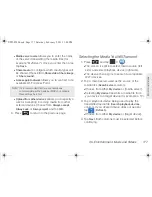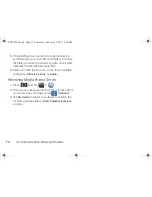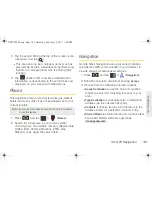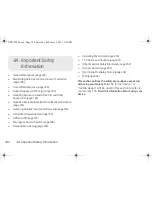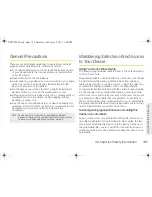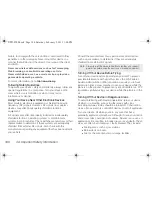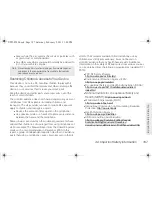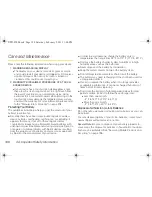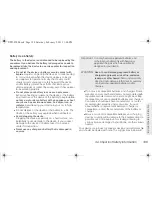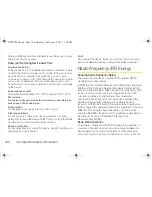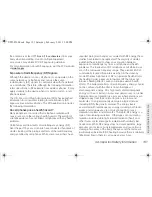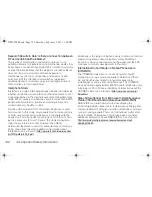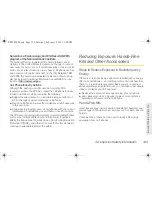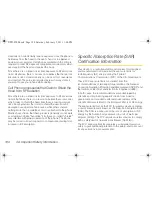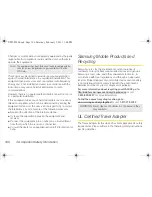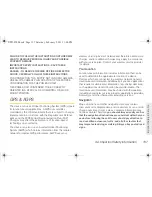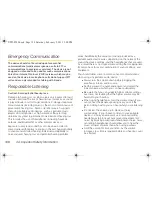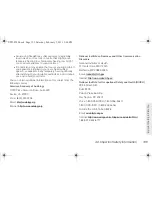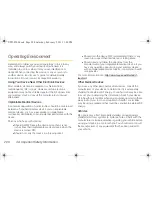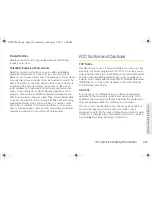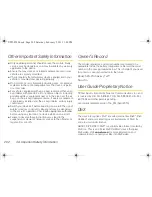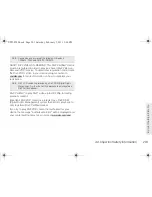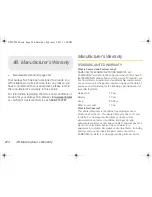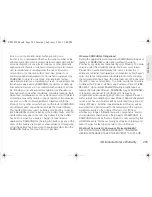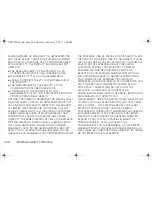
4A. Important Safety Information
191
Im
por
tan
t Sa
fe
ty
In
fo
rm
at
ion
the antenna is at least
7/16 inch
(
1.5 centimeters
) from your
body when transmitting. Use of non-Sprint-approved
accessories may violate FCC RF exposure guidelines.
For more information about RF exposure, visit the FCC website
at
www.fcc.gov
.
Exposure to Radiofrequency (RF) Signals
Although the device is not a cell phone, it can operate on the
same network as cell phones and can use the same
radiofrequency (RF) signals to communicate with the network
as a cell phone. Therefore, although the following information
refers specifically to RF exposure from wireless phones, it may
apply similarly to the device when it is being used on a cell
phone network.
The U.S. Food and Drug Administration (FDA) has published
information for consumers relating to radiofrequency (RF)
exposure from wireless phones. The FDA publication includes
the following information:
Do cell phones pose a health hazard?
Many people are concerned that cell phone radiation will
cause cancer or other serious health hazards. The weight of
scientific evidence has not linked cell phones with any health
problems.
Cell phones emit low levels of radiofrequency energy (RF).
Over the past 15 years, scientists have conducted hundreds of
studies looking at the biological effects of the radiofrequency
energy emitted by cell phones. While some researchers have
reported biological changes associated with RF energy, these
studies have failed to be replicated. The majority of studies
published have failed to show an association between
exposure to radiofrequency from a cell phone and health
problems. The low levels of RF cell phones emit while in use
are in the microwave frequency range. They also emit RF at
substantially reduced time intervals when in the stand-by
mode. Whereas high levels of RF can produce health effects
(by heating tissue), exposure to low level RF that does not
produce heating effects causes no known adverse health
effects. The biological effects of radiofrequency energy should
not be confused with the effects from other types of
electromagnetic energy. Very high levels of electromagnetic
energy, such as is found in X-rays and gamma rays can ionize
biological tissues. Ionization is a process where electrons are
stripped away from their normal locations in atoms and
molecules. It can permanently damage biological tissues
including DNA, the genetic material. The energy levels
associated with radiofrequency energy, including both radio
waves and microwaves, are not great enough to cause
ionization of atoms and molecules. Therefore, RF energy is a
type of non-ionizing radiation. Other types of non-ionizing
radiation include visible light, infrared radiation (heat), and
other forms of electromagnetic radiation with relatively low
frequencies. While RF energy does not ionize particles, large
amounts can increase body temperatures and cause tissue
damage. Two areas of the body, the eyes and the testes, are
particularly vulnerable to RF heating because there is relatively
little blood flow in them to carry away excess heat.
SPH-P100.book Page 191 Saturday, February 5, 2011 3:00 PM
Summary of Contents for Galaxy Tab SPH-P100
Page 13: ...Section 1 Getting Started SPH P100 book Page 1 Saturday February 5 2011 3 00 PM ...
Page 18: ...SPH P100 book Page 6 Saturday February 5 2011 3 00 PM ...
Page 19: ...Section 2 Your Device SPH P100 book Page 7 Saturday February 5 2011 3 00 PM ...
Page 137: ...Section 3 Sprint Service SPH P100 book Page 125 Saturday February 5 2011 3 00 PM ...
Page 194: ...SPH P100 book Page 182 Saturday February 5 2011 3 00 PM ...
Page 224: ...SPH P100 book Page 212 Saturday February 5 2011 3 00 PM ...
Page 238: ...SPH P100 book Page 226 Saturday February 5 2011 3 00 PM ...

